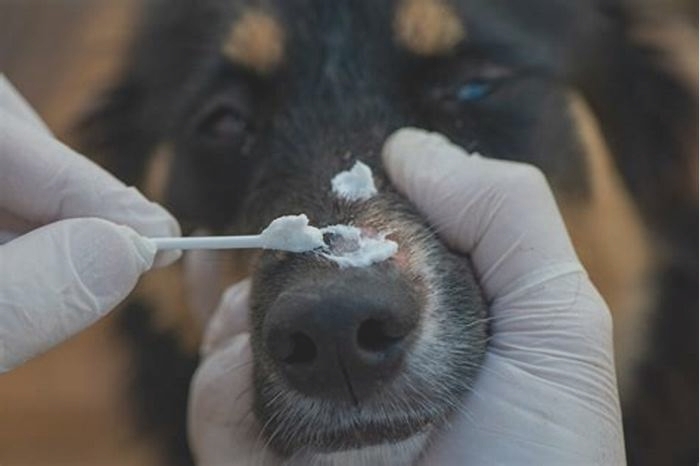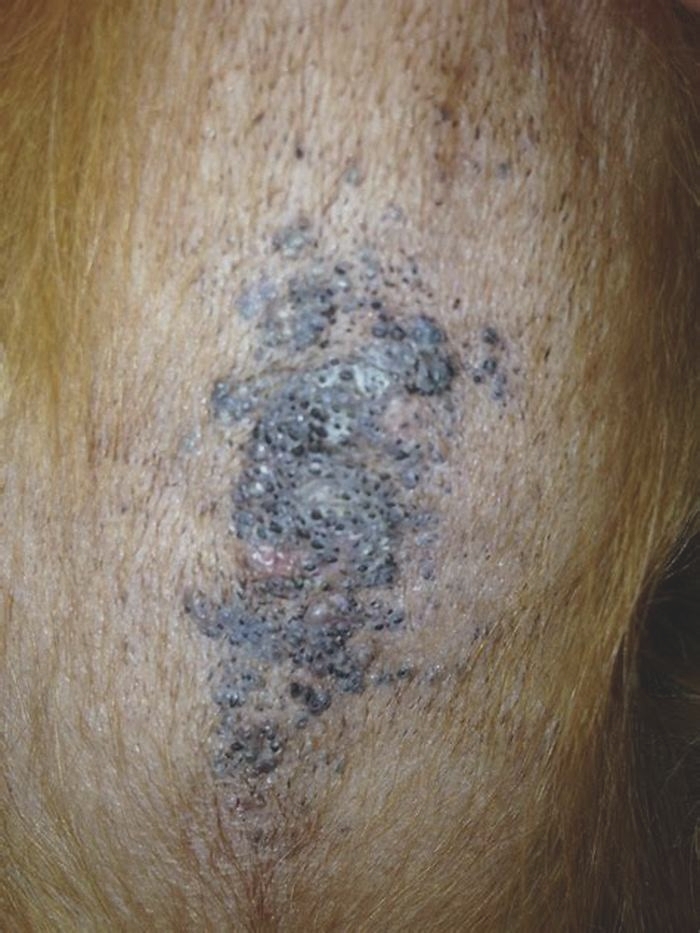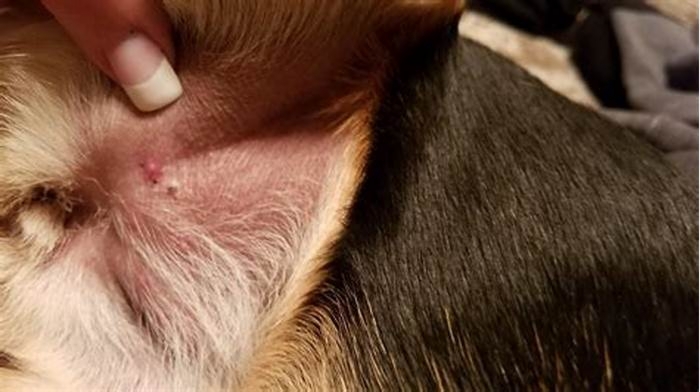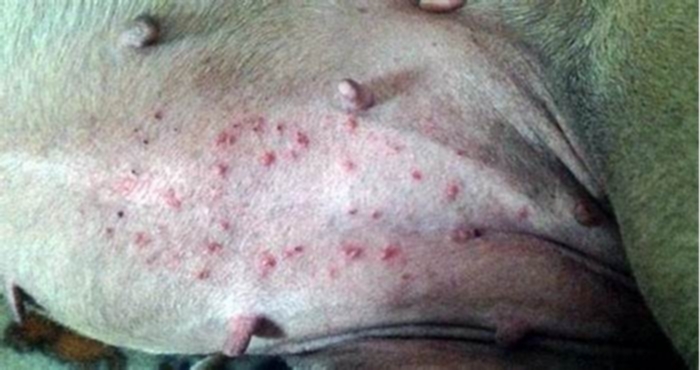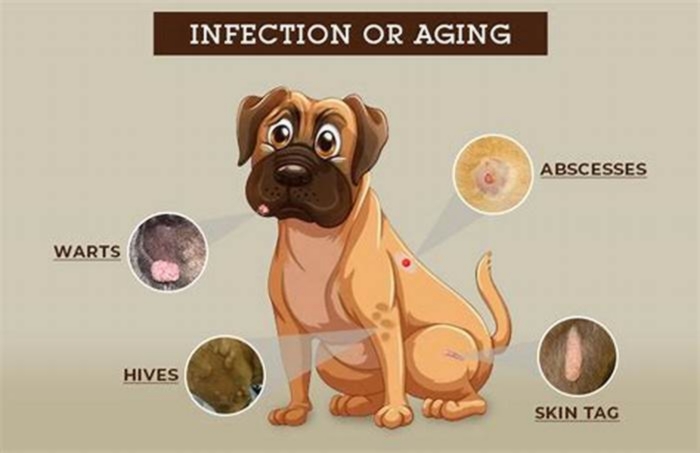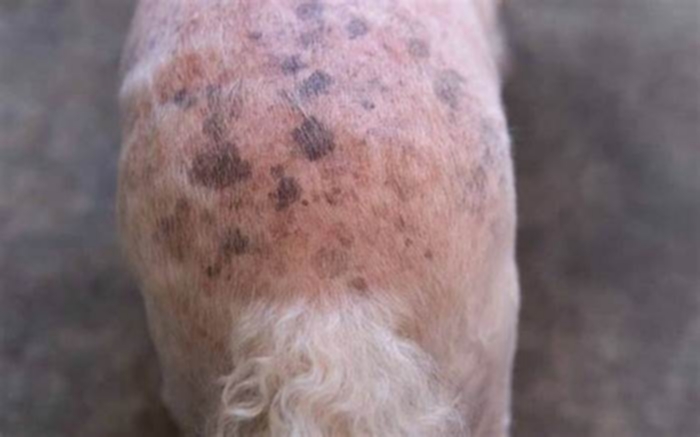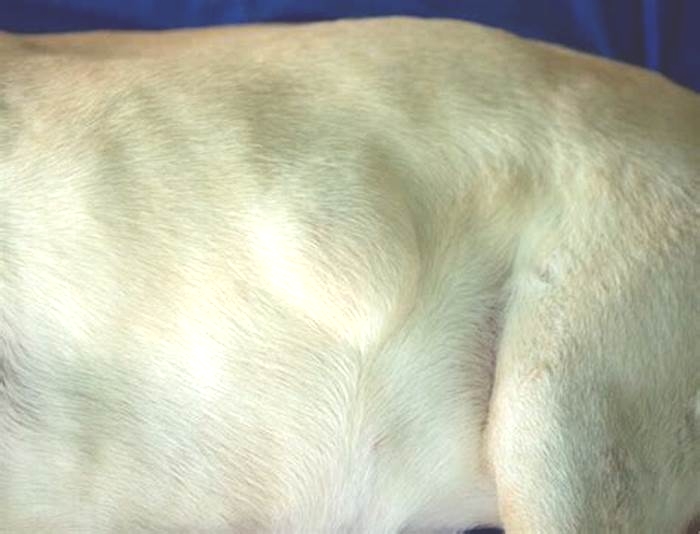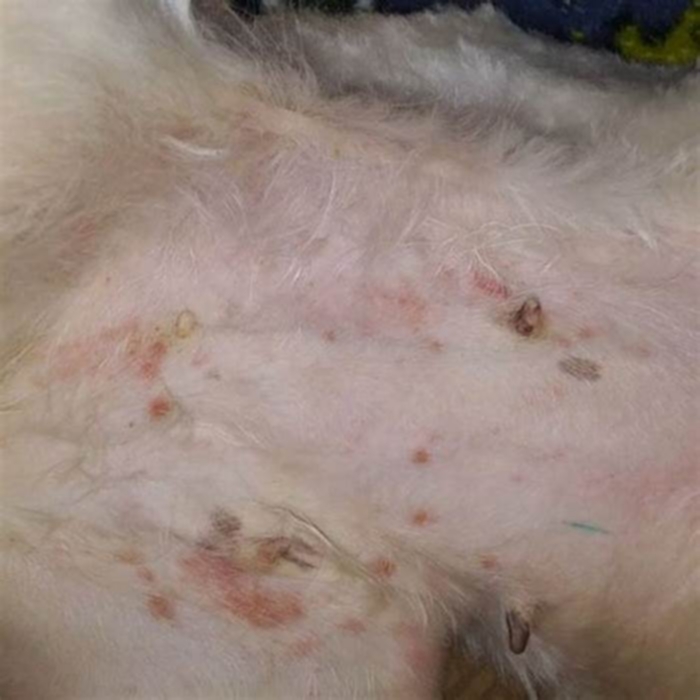Do dogs get blackheads on belly

Dog Blackheads on Belly: How You Can Manage This
Most of us have dealt with our own acne or skin issues at one point or another.
But have you ever had to contend with dog acne or dog blackheads on their belly?
If youre a dog parent, you might have encountered some spots or blackheads on your dogs skin.
Or maybe youve found some black spots on your dogs stomach, and youre trying to figure out what they are.
It can happen:
Its true that dogs can suffer from acne and skin conditions that were already familiar with and might have battled ourselves at some point.
If the latter is the case, then you know how difficult it can be to treat.
We all want our pets to be in good health and that includes their skin.
While blackheads and dog acne arent usually a serious condition, they can be indicators of an underlying problem.
So treating your dogs acne is less about making sure the other dogs in the park arent teasing them and more about ensuring everything is normal with their health.
Theres no need to panic.
Well say right away:its rarely a cause for concern, and dog acne and the accompanying conditions can be easily managed.
Online Veterinary 24/7
Chat With A Veterinarian OnlineConnect with a verified veterinarian in minutes. No waiting for appointments or office hours. No high fees. Your pet's health made convenient and worry-free.
What Are the Signs of Dog Acne?
Since most of a dogs body is covered in thick, sometimes dark hair, acne and blackheads might not be easily noticed.
Youre more likely to find blackheads or acne in areas where your dog has thinner hair, such as the insides of their ears, under their chin, and muzzle.
Most likely:
The soft skin on their tummy is where youll probably notice blackheads. In darker-skinned dogs, they might not be evident.
Blackheads can be a small spot, but if left untreated, they can grow larger. There can be one or several.
Sometimes, theyre so small that you might not be able to notice them by looking.
A belly rub could be your first clue that somethings up; blackheads can feel bumpy or hard.
If youve ever seen a blackhead on yourself, its easy to identify them on your dog, provided theyre not too dark, or theres too much hair in the way.
But dont try to slap a pore strip on them to solve the problem more on that later.
Acne and pimples are commonly seen on the underside of the chin or around the lip area beneath the nose.
These can appear to be large, red bumps and are a little more difficult to diagnose at home.
Other causes?
There are several other causes for bumpy red skin around the mouth, so a vet is the best person to diagnose acne that presents itself as red bumps.
Dog blackheads and acne dont typically bother your dog, but pimples can sometimes become inflamed, sore, or even infected.
Popping them might cause your dog pain and is best left to the vet if they decide an extraction is an option.
Its the other conditions that come with acne and blackheads that might be some cause for concern and might be making your dog uncomfortable.
No, Dog Acne Isnt from Eating Too Much Pizza
The causes of acne in dogs arent the usual suspects when we think of breaking out.
Greasy foods, hormones, and stress wont make your pup break out.
And similarly, nothing you buy at the pharmacy will be of much help.
So if a pore strip or a day at the spa wont do anything for your pup, how do you get rid of unsightly blackheads and acne?
The first step youll need to take is to identify the underlying cause of your dogs acne.
Even though the skin condition isnt likely to cause your dog any discomfort, it can be a symptom of something else that should be addressed.
So, what could be causing acne in dogs?
Cushings Disease
This is more likely to affect middle-aged or elderly dogs. Its usually caused by a tumor on the pituitary gland.
One of the symptoms of Cushings Disease, orCD,is thinning skin.
This can lead to the appearance of blackheads, lesions, or calcium deposits on softer skin like the belly.
Many pet owners think the signs of CD are just a part of normal aging lack of energy and weakness are among the typical symptoms.
But there are a few other things to look out for if your dog has blackheads on their belly.
First and foremost, consider their age, as dogs older than eight years old are more likely to develop the condition.
There are some breeds more prone to CD, such as poodles and dachshunds.
Increased thirst and urination, hair loss, and obesity are also signs to look out for.
So if those blackheads are one of the symptoms listed above, consult with your vet so they can properly test for the condition.
It can be expensive and time-consuming to treat, but it is something your dog can live comfortably with.
Demodex Mites
You might be more familiar with the phrase mange, which is the condition caused by Demodex mites.
Mange can be mild to severe, but most well-loved pets arent left to deteriorate to the point theyre losing hair all over.
However, you might notice some signs of mild mange in your well-loved pet.
Demodex mites already live on dogs, and theres not much we can do about it.
Its similar to the mites people have living in their eyelashes sorry if that fun fact ruined your day.
Actually, a few of these Demodex mites can be beneficial to dogs and act like a probiotic.
Theyre thought to be a vital part of your dogs skin health, provided theres no overgrowth of them.
Sometimes otherwise healthy dogs have a patch on their skin where the mites have multiplied. And they can also cause blackheads or scaly skin.
Most small mange spots are no cause for alarm and clear up on their own.
But if the spot spreads or shows no signs of improving, it could mean your dog is suffering from an autoimmune disorder.
Dogs that suffer from severe mange are often strays, malnourished, or anemic.
So if your healthy dog has multiple growing patches of mange, the vet will need to check for immunodeficiencies.
Mange can also be passed on to newborn puppies from their mother.
Since their immune systems arent fully developed, they could have an infestation of Demodex mites.
What to look out for?
Symptoms of mange include hair loss, scratching or licking the affected area, and red, scaly skin.
You might notice blackheads or pimple-like bumps on the belly or areas where the hair is naturally thin.
Its fairly straightforward to treat mild to moderate mange in dogs. Shampoos and topical ointments usually do the trick.
Dont tell your dog, but if you use topical medications, they might be inside for a few days in the cone of shame licking those medications off of themselves could make them ill.
Seborrhea
This condition is responsible for things like greasy skin and dandruff in humans.
In dogs, it can cause the same issues. There are two different forms of seborrhea; one that causes dryness and one that causes an overproduction of oil.
Dogs can have one or a combination of both, but blackheads are likely to pop up if theyre dealing with oily skin.
The greasy substance that causes these skin disorders can build up and become irritating in areas like the armpits, ears, and belly. Your dog might be scratching a lot in these places.
If dryness is part of the issue, youll see flaky skin in their fur, just like dandruff that plagues people.
Retrievers, Basset Hounds, Spaniels, and German Shepherds are among the breeds more susceptible to the skin condition, although it can affect any dog.
If your pets coat seems overly greasy, they have blackheads or acne and seem to be itching certain areas frequently. Theyre probably producing too much oil in their skin.
And sometimes, that overproduction of oil becomes a little smelly.
If your best friend is making you hold your nose every time you cuddle (and we dont mean from gassiness), then that could be another indicator of seborrhea.
The smell can be mild to intense and sometimes has a faint fishy odor.
Getting it treated is good for clearing that acne and protecting them from secondary skin infections from bacteria or yeast, both of which thrive in that oily environment.
Medicated shampoos andkeratolytic productsusually do the trick, although be sure to stick with what your vet recommends.
A word of warning:
Some ingredients in your shampoo might work great for you but could harm your dog.
The fur baby might be in for some extra baths until this condition clears up overbathing wont help, but a regular bathing regimen should be on the schedule for a while.
Getting Rid of Dog Blackheads on Belly for Good
Dog blackhead removal isnt as easy as extracting them as we do on our own skin.
As weve already said, the root cause has to be taken care of before you can expect their skin to clear up in the long term.
If you want to know how to get rid of dog blackheads, youll need to identify the cause clogged pores and comedones in dogs are the symptoms of something else.
So going to town and popping them wont do any good, and its not recommended by vets.
The spots will just come back, and youre putting your dog at risk for secondary skin infections.
If you pop a pimple on your dogs skin, you could also cause asebaceous cyst.
Theyre painful, theyre not pleasing to deal with, and theyre not worth popping any pimples in an attempt to clear up your dogs skin.
So as tempting as it might be, dont squeeze your dogs spots.
Not only can you worsen the condition, but youre not helping the underlying cause.
So is there anything you can do?
Once you and your vet have figured out why your dog is experiencing these breakouts, there are a few things you can try to kick the acne to the curb while your dog is receiving other treatments.
Some of the medications prescribed for the real reason behind your dogs acnewill help the shampoo and ointments mentioned for seborrhea, for instance, will go a long way in helping clear up their skin.
In the meantime, your vet might suggest benzoyl peroxide washes (weaker than the kind people use, so dont reach for that bottle on your sink just yet).
In severe cases, oral antibiotics could be prescribed to help get your dogs skin back to normal.
In short dont squeeze.
Our own dermatologists preach those words to us, and the vet will do the same when it comes to your dogs acne.
The vet will probably not attempt extraction unless your dog has a severely clogged pore. And in that case, best to leave it to the professionals.
Leave the Spots to Dalmatians
And every other lovely spotted breed out there.
Skin conditions on your dog can be as upsetting as if you were dealing with them on yourself.
But its essential to remember: theyre more often than not an indicator of something else.
But that doesnt mean your pup is stuck with blackheads and acne forever, and they wont have to simply grow out of it, like a lot of people do.
Any unusual skin ailment warrants a call to your trusted vet, who can help you figure out what is really to blame for your dogs acne.
And while dog blackheads on a belly might besotempting to squeeze, remind yourself that you could be making the situation worse.
Keep the pore extractors, harsh medications, and pore strips for yourself.
Even though you shouldnt use your products on your dog, there are several options available for helping get your dogs skin back in order.
The only catch? Many of these treatments will involve a B-A-T-H, possibly as often as once a week.
So you might want to have some extra towels handy and prepare for that post-bath shake that dogs love to share with us.
Dog Blackheads: What Clogged Pores Tell You About Your Dogs Health

Dog blackheads might give some flashbacks to high school and the horrors of problem skin. With canines, swollen pores with black or reddish-brown gunk can appear anywhere. Its not uncommon to find blackheads on their back, neck, chest, and even nipples.
But dogs get blackheads for different reasons than humans do, and many of these reasons are actually a cause for concern. Of course, ensuring our dogs are properly groomed with a gentle dog wash is part of the solution (and prevention). This way, we keep excess grease from building up in their pores.
But to get into blackheads and what they mean, weve consulted the Clinical Atlas of Canine and Feline Dermatology to arrive at the root of the problem.
Why do dogs get blackheads?
Many dogs, especially certain purebreds, are prone to blackheads. They often result from mites, or seborrhea, where the skin produces too much keratin that clogs the pores. Serious conditions like Cushings disease, diabetes, and cancer can cause clogged pores.

So, if youve found dilated pores on your dog that are filled with black gunk, it most likely is a blackhead. However, clogged pores just a phase for adolescents the way they are for most humans. It often signals a bigger problem.
Read this article if your dog has also developed pimples or dog acne.
How do dogs get blackheads?
Before we get into the many possible causes, we need first to understand what blackheads, called comedones, really are.
Each dog hair follicle produces keratin for the hair and has a sebaceous gland, which produces sebum to moisturize the skin and coat. An excess of keratin and sebum can clog the pore.
Essentially, a dogs pores become filled with the skins natural oils (sebum), keratin, dead skin cells, and other debris, as in the case of oily seborrhea.
However, a number of underlying problems can cause the skin to produce too much oil, creating blackheads. Sometimes the problems are genetic, but they can also happen from a mite infestation or certain types of cancer.
Warning! Canine blackheads are often not really blackheads
One point to note is that dog dermatology is complicated, and sometimes one disorder can look like another. Sometimes they overlap. For instance, if you are googling blackhead on dog belly or blackhead on dogs privates, the problem may actually be folliculitis.
This would be inflamed hair follicles from bacteria or perhaps yeast. It often affects a dog between the toes, the belly, the armpits, or the genitals. In turn, folliculitis is a sign of many other problems, usually related to various skin infections.
This is not the only example of potential confusion, but it is one to keep in mind if you spot a blackhead.
What causes canine blackheads?

The most common cause of clogged pores in dogs is a problem with keratin and sebum production, causing seborrhea. However, if you find blackheads on your dog, its essential to consider the many underlying conditions. Lets review what causes blackheads.
1. Canine Acne
Dogs often develop comedones and papules on the chin area. See our articles on dog acne and folliculitis if your dog is developing clogged pores, bumps, or cysts on their facial or mostly chin area.
2. Primary Seborrhea & Genetic Problems
Certain breeds sometimes develop primary seborrhea that may cause blackheads. Seborrhea is caused by a fault in how the skin, claws, or hair follicles produce keratin. This causes scaliness or dandruff and sometimes makes the coat greasy, clogging the pores.
Primary seborrhea is not itchy but may become itchy if the dog gets a secondary yeast or bacterial infection.
Dog breeds most likely to get this are:
- Cocker Spaniels (American and English);
- English Spaniels;
- Bassets;
- West Highland White Terriers;
- Retrievers (Golden & Labradors); and
- German Shepherds.
Another type of inherited disorder is Schnauzer Comedone Syndrome. In these cases, Schnauzers have defective hair follicles, and small scabs or blackheads appear on their back and neck. It can also affect other rough-coated terriers like the Cairn Terrier or Scottish Terrier.
Seborrhea symptoms: Oily Seborrhea vs. Dry Seborrhea
One should also remember there is a difference between dry and oily seborrhea. Dogs with a greasy coat and bad smell, even after a bath, may have whats called oily (oleosa) seborrhea. This means there is an overproduction of grease, and dogs with this problem have the most blackheads.
But in the case of dry seborrhea, the skin does not produce enough sebum. This means dandruff and scales from dry skin. It can also damage the natural water barrier of their skin, leading to secondary (usually itchy) skin infections like black scabs from pyoderma. Remember, secondary seborrhea often leads to yeast or bacterial infections.
Most dogs with seborrhea have both the oily and dry kind. So if you see blackheads, look for areas with dry skin that may need more moisture.
3. Secondary Seborrhea
One can only know if a dog has primary seborrhea by ruling out if they have the second kind. This is when the underlying condition disrupts the balance in the skin and causes pretty much the same symptoms. It may or may not be itchy.
So if dogs show signs of seborrhea, your veterinarian always needs to check for the following:
Hormonal imbalances
One of the major reasons middler-aged or senior dogs get blackheads is because of a hormonal problem. The major culprit is usually Cushings disease (hyperadrenocorticism) or hypothyroidism. One is a problem with the thyroid, and the other is with the adrenal gland. Another possibility is diabetes.
In these cases, you may also see hyperpigmentation or changes in the color and texture of the skin, like brown spots.
Allergies
In dogs younger than five, the common cause of blackheads from Seborrhea is allergies. A huge clue is a lot of itchiness and scratching, and you may see a lot of gunk in the ears, so check out our chart on ear discharge colors.
Demodex mite
After seborrhea, the second most common cause of blackheads in dogs are Demodex mites. These will usually be hairless patches filled with blackheads. Sometimes, they are itchy, but not always.
It can often look like acne because it can form pustules around the mouth area. Other signs include hair loss, crusts, and scabs. These mites live deep in the hair follicles and sebum glands, so an infection can definitely cause comedones. Be careful; its highly contagious.
Nutritional deficiencies
Nutrition plays a major role in skin health. Specifically, diets low in protein, B vitamins, zinc, and the omega-3 fatty acid, EPA, often cause skin issues like seborrhea.
Large, growing puppies are often deficient in zinc, as are Northern Breeds like Huskies, and may need supplements. Dogs also need enough vitamin E, A, pantothenic acid, pyridoxine, biotin, and vitamin A for a healthy coat.
However, these nutrients need to be properly balanced. Dogs eating unbalanced diets are at risk of more severe health problems.
Skin Lymphoma
Dogs with skin lymphoma may also get blackheads. Typically these can be any lesions, such as red patches, nodules, papules, ulcers, scales, or alopecia. This usually develops into a thick, red area with ulcers that may leak fluid.
Immune-system diseases
Immune system disorders such as pemphigus or lupus can also cause secondary seborrhea. Its usually complicated, but many autoimmune diseases attack the integrity and health of the skin and coat.
Pressure sores (calluses) & Friction Blackheads
Another place you may find blackheads are on your dogs elbows or hocks. These spots are usually where your dog (typically an older dog from a large breed) may be pressing on hard ground when lying down. This causes calluses to develop or hard spots that may have comedones or infected hair follicles.
A good paw balm can moisturize and soften these areas. But you may see blackheads on them because repeated friction damages the hair and irritates the hair follicle. This can cause them to become clogged.
Sometimes blackheads form under a dogs armpits or groin area because of the rubbing and friction. It may also happen in dogs with skin folds.
Overuse of Medication
Dogs on certain medications for a long time, specifically oral steroids, often develop skin issues, including blackheads.
Growths & tumors
If the blackheads seem to be growing into lumps and bumps, then pet parents need to be concerned about tumors. One problem may be growths in the sebaceous glands called sebaceous adenoma. These can look a bit like skin tags.
If blackheads seem to grow, become raised or lumpy, have irregular coloring or develop into sores that wont heal, speak to your vet immediately.
Obesity
Sadly, being overweight can also cause many skin issues in dogs, including blackheads. Obese dogs have more circulation issues and tend to have generally unhealthy skin. They are also more prone to issues like diabetes, which can cause secondary seborrhea and blackheads.
Chinese Crested Blackheads (comedones in hairless dogs)
It appears that blackheads and acne in hairless dogs such as Chinese Crested or the Xoloitzucuintlis are different from other dogs. It seems to be much more similar to human acne.
This is because it seems to be epidermal lipids, such as ceramides and fatty acids, behind skin issues. But in other dogs, blackheads are usually clogged hair follicles.
How do I get rid of blackheads on my dog?
If you see blackheads on your dog, the first thing to do is see a vet and start the process of elimination. If the blackheads are on the chin, part of the facial area, and part of a simple acne outbreak, they respond well to benzoyl peroxide cleanser.
However, if its not just facial acne, follow the following steps to address your dogs skin problems.
Step 1: Do blood tests on your dog for underlying conditions such as Cushings, diabetes, lupus, or hypothyroidism.
Step 2: Have your vet rule out demodectic mange.
Step 3: Ask for ELISA testing and start testing for possible allergens. These could be in your dogs environment, like pollen or food allergies.
Step 4: Ask your vet to examine your dog for any suspicious lumps or signs of cancer-related skin issues.
Step 5: Ask your vet about shampoos for flushing the follicles in oily seborrhea.
Step 6: bathe any hairless breed with a gentle shampoo and skin moisturizer every one-to-weeks to prevent oil build-up.
Step 7: Look to add fish oil supplements and aim for at least 20mg of EPA per pound of body weight daily. You can also increase vitamin E to about 300 IU per day. Speak to your vet about possible zinc supplements.
Step 8: Speak to your vet about retinoids and other topical treatments for seborrhea. Retinoids should help the skin purge comedones.
Can I pop my dogs blackheads?
Never pop your dogs blackheads. Not only does it spread bacteria, as with humans, but a dogs skin has a much higher PH. This makes them extremely vulnerable to secondary bacterial and yeast infections when their skin breaks.
If your dog has mites, then popping the blackhead is a great way to spread this contagious parasite.
So how do you get rid of dog blackheads?
Dog blackheads removal:
Firstly, never try to remove the blackhead yourself. After your vet has treated any underlying problem, you can use the following to remove blackheads.
- If your dog has mild blackheads, gently scrub the area about once every two weeks to exfoliate it.
- You can apply a safe Benzoyl peroxide or ointment to the area. Speak to your vet about a salicylic acid (BHA) solution, but be careful as it is too strong and can damage your dogs skin further and even cause a chemical burn. So do not use human acne or blackhead treatments from your own stash as they can have adverse effects on your dog.
- Be careful not to overwash or under wash your dog. Overwashing strips the coat of natural oils and creates dry skin problems. But not washing your dog enough can cause the oil to build up and clog pores.
Final Thoughts
Blackheads on dogs may seem a minor issue and nothing to worry about. Indeed, sometimes you can treat it along with dog acne if its on the face. But skin conditions in dogs often have an underlying cause that needs veterinary treatment.
If you spot blackheads on dogs, be sure to take your dog for a check up. Since problems like Cushings disease or even tumors can cause clogged pores, its best not to ignore them.
Meet Your Experts
Tamsin De La Harpe
Author
Tamsin de la Harpe has nearly two decades of experience with dogs in rescue, training, and behavior modification with fearful and aggressive dogs. She has worked closely with veterinarians and various kennels, building up extensive medical knowledge and an understanding of canine health and physiology. She also spent two years in the animal sciences as a canine nutrition researcher, focusing on longevity and holistic healthcare for our four-legged companions.Tamsin currently keeps a busy homestead with an assortment of rescue dogs and three Bullmastiffs.
Tamsin de la Harpe has nearly two decades of experience with dogs in rescue, training, and behavior modification with fearful and aggressive dogs. She has worked closely with veterinarians and various kennels, building up extensive medical knowledge and an understanding of canine health and physiology. She also spent two years in the animal sciences as a canine nutrition researcher, focusing on longevity and holistic healthcare for our four-legged companions.Tamsin currently keeps a busy homestead with an assortment of rescue dogs and three Bullmastiffs.

